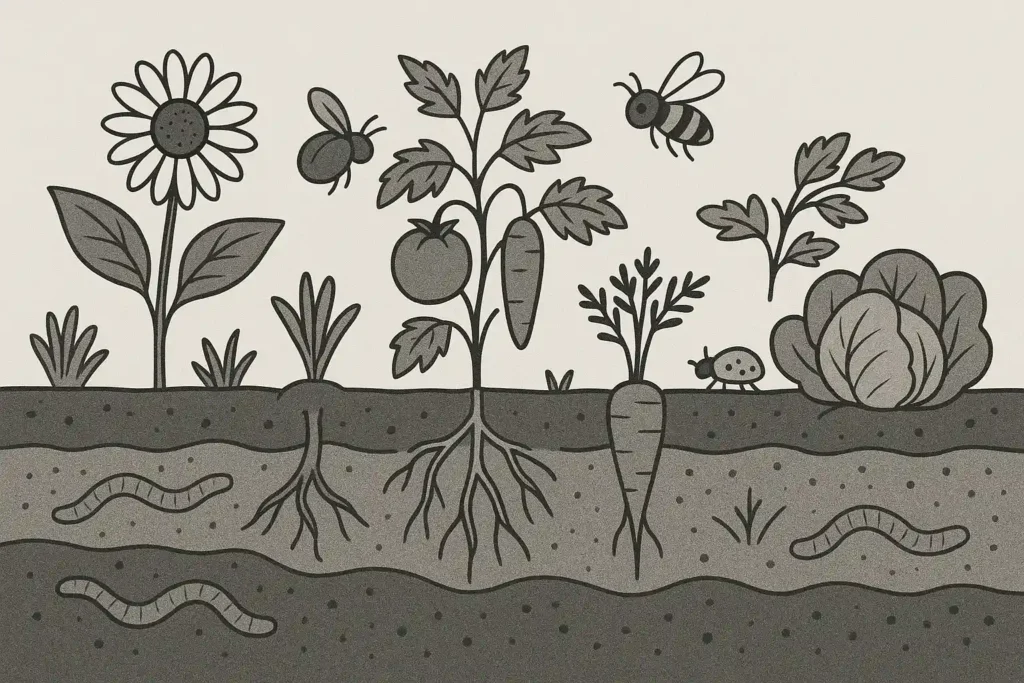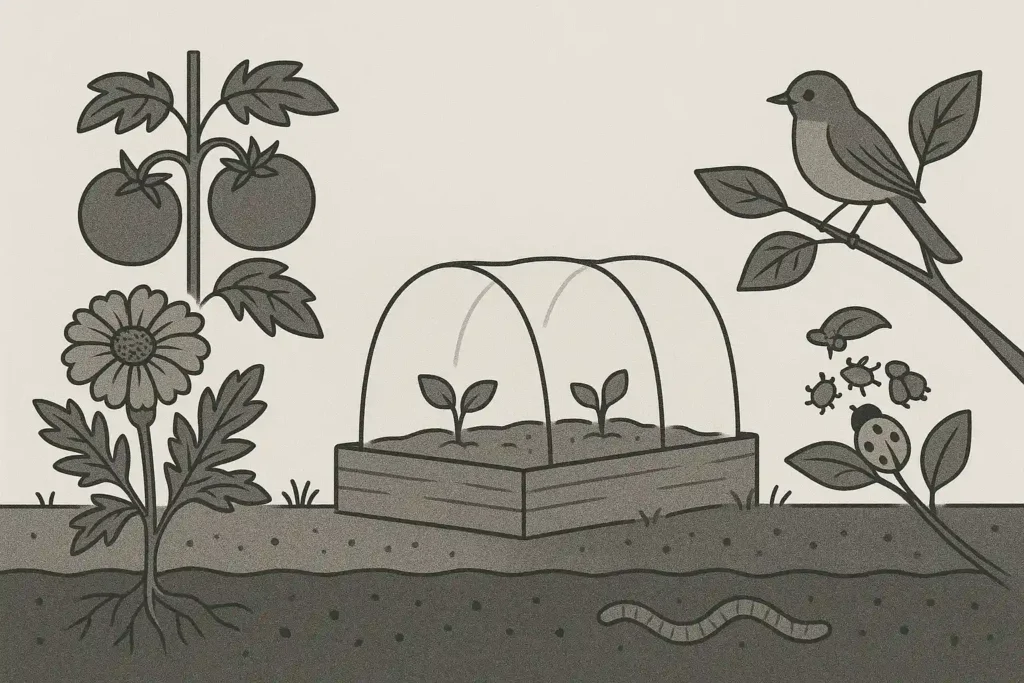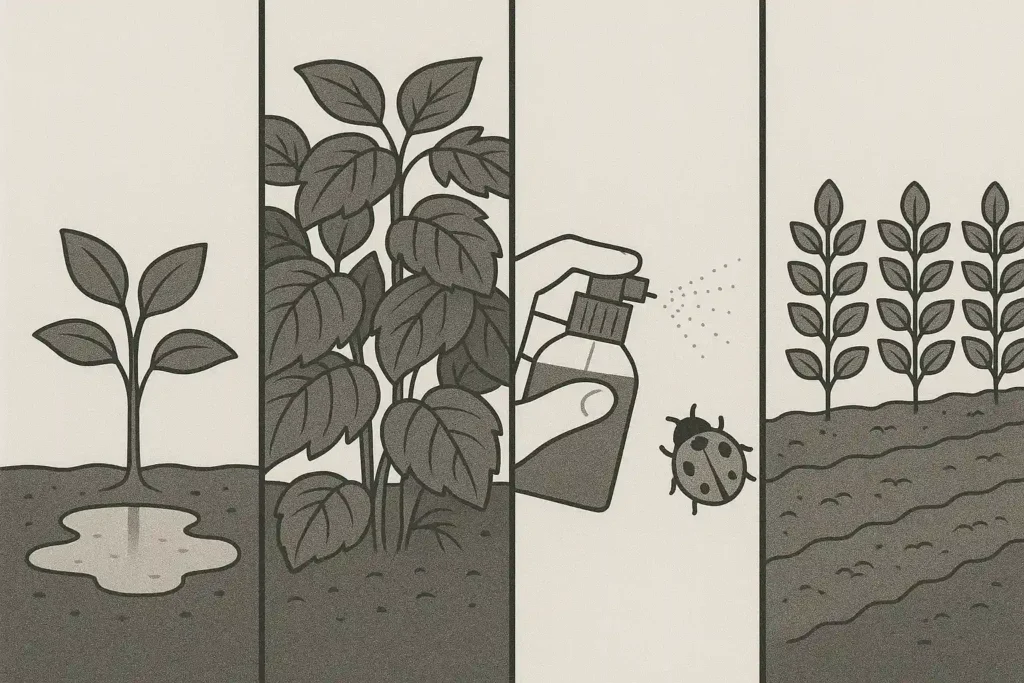Pest problems don’t always need harsh treatments. There are natural methods that help protect plants without damaging the balance of your garden. This article covers seven practical ways to keep pests out, including how to use certain plants, make your own sprays, apply powders like diatomaceous earth, and more. Each method works with nature, not against it.
Why Natural Pest Control Is Worth Considering

Chemical pesticides often kill more than their intended targets. Bees, ladybugs, and earthworms—vital to plant health—can be harmed just as easily as aphids or mites. Over time, repeated use affects the soil itself.
These chemicals can reduce microbial activity, interfere with nutrient cycles, and disrupt the natural breakdown of organic matter. Fewer microbes and fungi mean slower composting, weaker plant roots, and poorer soil texture.
Natural methods avoid these side effects. They make the garden less appealing to pests while supporting insects and animals that help manage them.
If you’re interested, you could also learn how to create your very own compost at home [almost for free] here.
Best Natural Ways to Keep Pests Out of Your Garden
These seven methods rely on physical deterrents, ecological support, and basic homemade treatments. They’re not quick fixes, but they work steadily by changing the conditions that allow pests to thrive.

1. Use Companion Planting to Distract or Repel Pests
Companion planting means placing plants near each other to benefit growth, flavor, or pest control. Some plants emit strong smells or chemical compounds that pests dislike. Others act as sacrificial crops—drawing pests away from your main harvest. The goal is to confuse insects and make it harder for them to find and damage your crops.
For example, marigolds release a compound called alpha-terthienyl, which repels nematodes in the soil. Basil helps reduce thrips and whiteflies when planted near tomatoes. Nasturtiums attract aphids and flea beetles away from vegetables like kale, acting like a decoy. Garlic and chives help repel carrot flies and spider mites.
This method also attracts beneficial insects. Planting herbs like dill, coriander, and fennel can increase the presence of lacewings and ladybugs—natural predators of soft-bodied pests.
A few proven pairings:
- Tomatoes + basil (repels hornworms, improves growth)
- Cabbage + dill (attracts wasps that feed on cabbage worms)
- Beans + rosemary (discourages bean beetles)
Over time, this strategy reduces the number of pests and the need for reactive treatments. It’s a longer-term method, but it works well when combined with the other techniques in this list.
2. Encourage Predators and Insect Allies
Natural pest control often comes down to encouraging the right insects and animals to take up residence in your garden. Instead of fighting pests yourself, you invite their natural enemies to do the work for you.
Ladybugs eat hundreds of aphids per day. Lacewing larvae feed on mites, whiteflies, and caterpillar eggs. Parasitic wasps lay eggs in caterpillars and beetles, stopping the next generation before it starts. Birds like wrens and chickadees eat beetles, grubs, and caterpillars, especially in spring when they’re feeding their young.
To attract these allies:
- Grow pollen-rich flowers like yarrow, fennel, sweet alyssum, and buckwheat.
- Leave small patches of undisturbed ground or mulch for ground beetles.
- Avoid broad-spectrum sprays that kill both good and bad insects.
- Add a shallow dish of water with stones for bees and birds.
- Install birdhouses and leave dead wood for solitary bees.
According to data from Michigan State University, gardens with predator-friendly habitats can reduce aphid populations by up to 75% over a single season.
This method won’t eliminate pests overnight, but it creates lasting pressure on their populations. It also helps build a more diverse and stable garden environment overall.
3. Homemade Natural Sprays (Safe and Effective for Routine Use)
Homemade sprays offer a way to intervene when pest numbers spike beyond what companion planting or natural predators can manage. They’re especially helpful for soft-bodied insects like aphids, mealybugs, mites, and young caterpillars. While sprays shouldn’t be your first line of defense, they can reduce populations fast without contaminating soil or harming most beneficial insects—if applied correctly.
Neem oil spray is one of the most commonly used options. It disrupts insect feeding and reproduction. Mix 2 teaspoons of cold-pressed neem oil with 1 teaspoon of mild soap in 1 quart of water. Shake well before each use. Spray in the evening to avoid affecting pollinators.
Garlic-chili spray acts as a strong repellent. Blend 1 head of garlic and 1 hot chili pepper with water. Let the mixture sit overnight, strain, then dilute to 1 quart. Spray on leaves and stems.
Soap spray kills insects on contact by damaging their protective coating. Use 1 tablespoon of pure liquid soap (not detergent) in 1 quart of water.
Usage tips:
- Only spray affected plants.
- Test on one leaf first to check for burn or damage.
- Repeat every few days until pest numbers decline.
These sprays don’t cure an infestation, but they help control it when other methods fall short.
4. Diatomaceous Earth and Other Natural Powders
Diatomaceous earth (DE) is a fine, white powder made from the fossilized remains of microscopic algae. It works by physically damaging insects rather than poisoning them. The particles are sharp on a microscopic level. When insects like ants, beetles, or slugs crawl across it, the powder slices into their exoskeleton and draws out moisture, eventually killing them by dehydration.
DE is most effective against:
- Ants
- Earwigs
- Aphids
- Slugs
- Flea beetles
It’s important to use food-grade diatomaceous earth in any garden setting. Avoid the type meant for pools—it’s processed differently and isn’t safe for plants or soil.
How to use:
- Lightly dust plant leaves, especially the undersides
- Sprinkle around the base of plants to create a dry barrier
- Reapply after rain or watering, as moisture reduces its effect
In addition to DE, wood ash and crushed eggshells can be used similarly. They irritate soft-bodied pests and act as deterrents around seedlings or vulnerable crops.
While effective, powders should be used with care. They can also harm beneficial insects if applied too broadly. Target the application to specific problem areas instead of covering your entire garden.
5. Physical Barriers and Manual Techniques
Sometimes the simplest defense is a physical one. Barriers and hands-on methods can prevent pests from reaching your crops in the first place. This is especially useful for larger pests—like birds, rabbits, and squirrels—or insects that target specific plants.
- Row covers (floating fabric sheets) can protect seedlings and young plants from flea beetles, cabbage moths, and even birds. The covers let in light and rain while keeping pests out.
- Netting or mesh is useful over fruiting plants like strawberries or blueberries. It deters birds without affecting airflow.
- Copper tape placed around raised beds or pots helps deter slugs and snails by reacting with their slime, creating a mild electric shock they avoid.
- Handpicking might seem tedious, but for small gardens, it’s effective. You can physically remove beetles, caterpillars, or eggs from the undersides of leaves. A bucket of soapy water nearby makes disposal quick.
Other tactics:
- Sticky traps for flying insects like whiteflies
- Beer traps to lure and drown slugs
- Collars around the base of young plants to block cutworms
These methods require more attention but give you precise control. They’re especially useful during early growth stages or after transplanting.
6. Keep a Clean and Healthy Garden
Pests thrive in neglected or overgrown environments. Fallen fruit, rotting leaves, overcrowded plants, and poor air circulation create the perfect conditions for infestation. A tidy, well-maintained garden naturally discourages many pests before they even show up.
Key habits that help:
- Remove debris regularly. Old leaves, weeds, and dead stems create shelter for slugs, beetles, and fungal spores.
- Thin out crowded plantings. Proper spacing allows airflow, which reduces moisture-loving pests like aphids and fungus gnats.
- Rotate crops. Repeating the same crop in the same spot each year increases the chance of pests returning. Crop rotation interrupts their life cycles.
- Water at the base, not the leaves. Wet foliage attracts fungal issues and mildew, which weaken plants and make them more pest-prone.
Composting helps too—but keep it separate from your growing beds. Use a closed bin or turn your pile frequently to prevent it from attracting rodents and flies.
According to the Royal Horticultural Society, gardens with consistent upkeep and spacing saw 30–40% fewer pest issues over the growing season compared to gardens left untended for even short periods.
7. Use Pest-Repelling Plants Around the Garden
Certain plants act as natural deterrents because of the compounds they release. Strong-smelling herbs, bitter-tasting leaves, or essential oils can keep specific pests away from nearby crops. These can be planted along borders, between rows, or in pots near entry points.
Common pest-repelling plants:
- Lavender: Deters moths, fleas, and mosquitoes.
- Mint: Repels ants, cabbage moths, and aphids (keep it in pots—it’s invasive).
- Rosemary: Keeps cabbage loopers, carrot flies, and some beetles away.
- Sage: Protects against carrot flies and cabbage moths.
- Lemongrass: Contains citronella, which repels mosquitoes and aphids.
For broader protection, you can also plant pyrethrum daisies (Chrysanthemum cinerariifolium), which naturally contain a compound used in many commercial insecticides.
Tips:
- Mix repellent plants with your vegetables, not just at the edges.
- Replace or trim them as they get woody or lose fragrance.
- Use freshly crushed leaves around problem zones for a short-term effect.
4 Common Mistakes to Avoid
Missteps in natural pest control often come down to missing the full picture. Here are four widespread errors gardeners make—and how to avoid them:

1. Ignoring Early Warning Signs
Letting pest activity go unnoticed until damage becomes obvious makes control harder. Pests breed quickly. If you wait too long, even safe, plant-based treatments may struggle to keep pace.
Checking leaves, stems, and undersides regularly gives you a chance to act before infestations escalate.
2. Overwatering or Creating Excess Moisture
Persistent dampness encourages pests like fungus gnats, root rot‑causing insects, and slugs. Overwatered soil also hinders plant health, making them more vulnerable.
A well‑draining garden, careful watering at the soil level, and avoiding puddles or trays of standing water are key. According to gardening experts, overwatering ranks among the top issues that attract unwanted pests.
3. Eliminating Beneficial Insects
Some gardeners mistakenly kill insects that actually help. Broad, indiscriminate treatments—like spraying soaps or oils too widely—can harm the predators that control pests naturally.
Real‑world users report unwittingly wiping out ladybugs, lacewings, and solitary bees. Up to 99% of insect species in gardens provide benefits. Focused, careful use of any spray ensures you don’t destroy the help you already have.
4. Lacking Plant Diversity
Growing one type of crop in large blocks invites specialized pests to take over. Uniform plantings reduce insect and microbial diversity, allowing pests to multiply unchecked.
Gardens that mix vegetables, herbs, and flowering plants reduce pest pressure naturally. This encourages cycles of predators and prey that keep infestations in steadier balance. Lack of diversity is a well‑documented attractor for pests.
Summing Up
Natural pest control isn’t about instantly eliminating unwanted insects—it’s about steering conditions to favor balance. These gardening strategies help in three ways:
- They reduce the garden’s appeal to pests (e.g. repellent plants, physical screens)
- They invite or support predatory insects and wildlife
- They rely on good garden hygiene and regular monitoring
Used in combination, they lower pest numbers steadily over time without resorting to synthetic chemicals. You’ll have a garden ecosystem that resists pests, holds nutrients, and feels healthier overall.
FAQs
Use companion planting, maintain garden hygiene, attract beneficial insects, and apply homemade sprays like neem oil or garlic when needed.
There’s no single best method—combine repellent plants, physical barriers, and insect predators for steady, low-impact pest management.
It can help control fungal issues in small amounts, but overuse may affect soil pH and plant health.
Blend garlic, chili, or neem oil with water and mild soap; strain and spray on affected plants during early morning or dusk.
Vinegar can damage leaves and alter soil pH—use only in targeted areas, not directly on plant foliage.
This content is generated by AI, reviewed by our editorial team, and features products that have been thoroughly evaluated and chosen.





